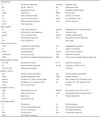Abstract
Objectives
Differential diagnosis based on descriptive psychopathology between bipolar and unipolar depression in the clinical setting is a still huge challenge. Projective psychological tests might provide additional clues. This study aimed to find distinct Rorschach test characteristics of bipolar depression in comparison with unipolar depression.
Methods
Medical records and raw data of the Rorschach Inkblot test applied using standardized procedure for the Exner Comprehensive System were retrospectively reviewed for patients with bipolar disorder or unipolar depression. Individual variables of the Rorchach test were compared among three groups, i.e., (hypo) mania (n=59), bipolar depression (n=56) and unipolar depression (n=25).
Results
Bipolar depression group, in accordance with (hypo) manic group, showed more color reponses (WSumC), more extroverted and intuitive decision-making (EBright), and higher emotional expression (CF+C) and instability (ebright), compared to unipolar deperssion group. On the contrary, the (hypo) mania group displayed more cognitive errors (Sum6, WSum6) compared to both depression groups.
Figures and Tables
Table 3
Comparison of the Rorschach test variables among bipolar mania, bipolar depression and unipolar depression groups: core section

References
1. Quitkin FM, Kane JM, Rifkin A, Ramos-Lorenzi JR, Saraf K, Howard A, et al. Lithium and imipramine in the prophylaxis of unipolar and bipolar II depression: a prospective, placebo-controlled comparison [proceedings]. Psychopharmacol Bull. 1981. 17:142–144.
2. Wehr TA, Goodwin FK. Rapid cycling in manic-depressives induced by tricyclic antidepressants. Arch Gen Psychiatry. 1979. 36:555–559.

3. APA. Diagnostic and Statistical MAnual of Mental disordersm. 1994. 4th edition. Washington, DC: American Psychiatric Association.
4. Leyton F, Barrera A. [Bipolar depression and unipolar depression: differential diagnosis in clinical practice]. Rev Med Chil. 2010. 138:773–779.
5. Akiskal HS, Benazzi F. Continuous distribution of atypical depressive symptoms between major depressive and bipolar II disorders: dose-response relationship with bipolar family history. Psychopathology. 2008. 41:39–42.

6. Van Valkenburg C, Akiskal HS, Puzantian V. Depression spectrum disease or character spectrum disorder? A clinical study of major depressives with familial alcoholism or sociopathy. Compr Psychiatry. 1983. 24:589–595.
7. Coryell W, Endicott J, Maser JD, Keller MB, Leon AC, Akiskal HS. Long-term stability of polarity distinctions in the affective disorders. Am J Psychiatry. 1995. 152:385–390.

8. Goldberg JF, Harrow M, Whiteside JE. Risk for bipolar illness in patients initially hospitalized for unipolar depression. Am J Psychiatry. 2001. 158:1265–1270.

9. Cassano GB, Rucci P, Frank E, Fagiolini A, Dell'Osso L, Shear MK, et al. The mood spectrum in unipolar and bipolar disorder: arguments for a unitary approach. Am J Psychiatry. 2004. 161:1264–1269.

10. Akiskal HS, Benazzi F. The DSM-IV and ICD-10 categories of recurrent [major] depressive and bipolar II disorders: evidence that they lie on a dimensional spectrum. J Affect Disord. 2006. 92:45–54.

11. Akiskal HS, Walker P, Puzantian VR, King D, Rosenthal TL, Dranon M. Bipolar outcome in the course of depressive illness. Phenomenologic, familial, and pharmacologic predictors. J Affect Disord. 1983. 5:115–128.
12. Meyer GJ, Archer RP. The hard science of Rorschach research: what do we know and where do we go. Psychol Assess. 2001. 13:486–502.

13. Ilonen T, Heinimaa M, Korkeila J, Svirskis T, Salokangas RK. Differentiating adolescents at clinical high risk for psychosis from psychotic and non-psychotic patients with the Rorschach. Psychiatry Res. 2010. 179:151–156.

14. Minassian A, Granholm E, Verney S, Perry W. Visual scanning deficits in schizophrenia and their relationship to executive functioning impairment. Schizophr Res. 2005. 74:69–79.

15. Exner J. The Rorschach: A comprehensive system. 1993. New york: Wiley.
16. Singer HK, Brabender V. The use of the Rorschach to differentiate unipolar and bipolar disorders. J Pers Assess. 1993. 60:333–345.

17. Osher Y, Bersudsky Y. Thought disorder in euthymic bipolar patients: a possible endophenotype of bipolar affective disorder? J Nerv Ment Dis. 2007. 195:857–860.
18. Mandel B, Last U, Belmaker RH, Rosenbaum M. Rorschach markers in euthymic manic-depressive illness. Neuropsychobiology. 1984. 12:96–100.

19. Osher Y, Mandel B, Shapiro E, Belmaker RH. Rorschach markers in offspring of manic-depressive patients. J Affect Disord. 2000. 59:231–236.

20. Decina P, Kestenbaum CJ, Farber S, Kron L, Gargan M, Sackeim HA, et al. Clinical and psychological assessment of children of bipolar probands. Am J Psychiatry. 1983. 140:548–553.

21. Nierenberg AA, Akiskal HS, Angst J, Hirschfeld RM, Merikangas KR, Petukhova M, et al. Bipolar disorder with frequent mood episodes in the national comorbidity survey replication (NCS-R). Mol Psychiatry. 2010. 15:1075–1087.

22. Pani PP, Maremmani I, Trogu E, Gessa GL, Ruiz P, Akiskal HS. Delineating the psychic structure of substance abuse and addictions: should anxiety, mood and impulse-control dysregulation be included? J Affect Disord. 2010. 122:185–197.

23. Swann AC, Steinberg JL, Lijffijt M, Moeller GF. Continuum of depressive and manic mixed states in patients with bipolar disorder: quantitative measurement and clinical features. World Psychiatry. 2009. 8:166–172.

24. Thase ME. Bipolar depression: Issues in Diagnosis and Treatment. Harv Rev Psychiatry. 2005. 13:257–271.

25. Correll CU, Penzner JB, Frederickson AM, Richter JJ, Auther AM, Smith CW, et al. Differentiation in the preonset phases of schizophrenia and mood disorders: evidence in support of a bipolar mania prodrome. Schizophr Bull. 2007. 33:703–714.

26. Bora E, Vahip S, Akdeniz F, Ilerisoy H, Aldemir E, Alkan M. Executive and verbal working memory dysfunction in first-degree relatives of patients with bipolar disorder. Psychiatry Res. 2008. 161:318–324.

27. Shin KJ, Won HT. Rorschach Responses in Korean Normal Adults. Korean J Clin Psychol. 1991. 10:206–216.
28. Yoo IO, Park SW, Joo YH. The Comparative Study of Manic Group and Schizophrenic Group on Rorschach Responses. Korean J Clin Psychol. 1993. 12:62–72.
29. Ogdon DP. Handbook of psychological signs, symptoms, and syndromes. 1981. California: Western psychological services.




 PDF
PDF ePub
ePub Citation
Citation Print
Print






 XML Download
XML Download